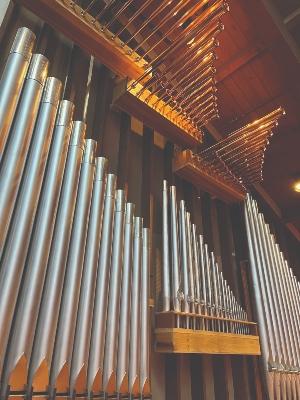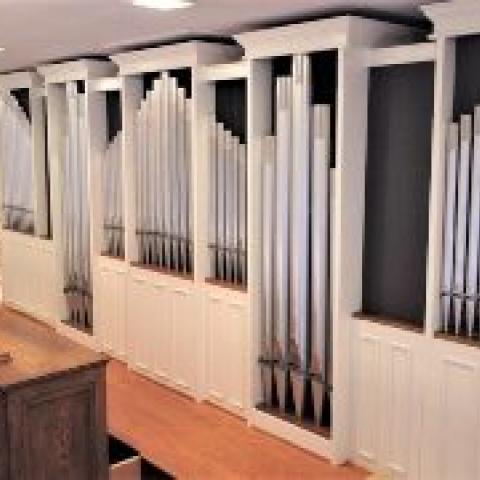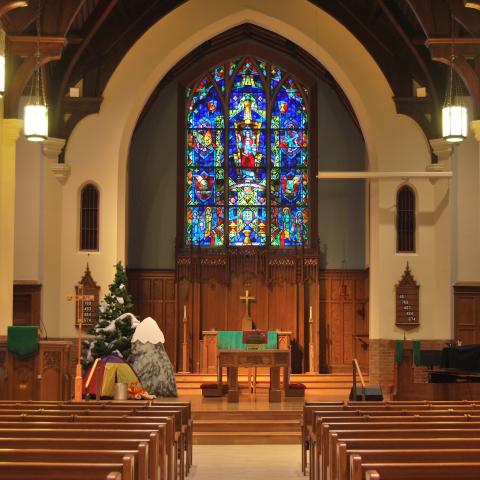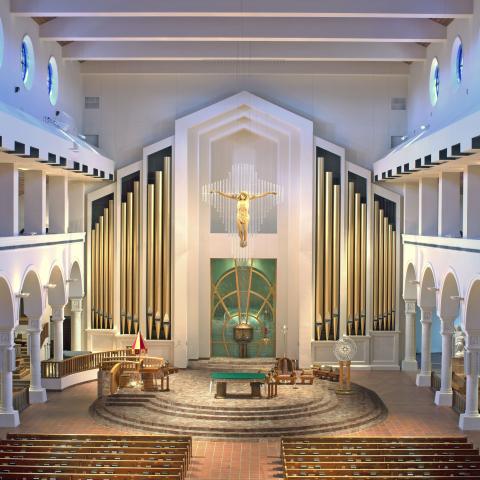
Marceau Pipe Organ Builders, Seattle, Washington
Kent Lutheran Church, Kent, Washington
The gallery organ, completed in December 2022, represents the first substantive milestone toward the completion of the “Kent Grand Organ” project. This instrument comprises twenty-one ranks, 1,290 pipes, and one tuned percussion (Wurlitzer Chysoglott). The symphonic tonal inclination, a rarity in the Pacific Northwest, is an extension of the tonal fabric of the main organ still in progress that will sit in the front of the church. The gallery organ possesses a full principal chorus including independent mixture, a secondary Spitz Principal beginning at 16′, independent mutations, stopped and harmonic flutes, Trompette en chamade, Fagotto, and eight varied ranks of strings and celestes, from hushed tapered Muted Violes to the assertive Oboe Gamba and Celeste. The entire organ is enclosed except for the 16′ Spitz Principal extension, the first octave of the 8′ Principal, and the Festival Trumpet.
The mechanical framework honors the legacy of the eminent Seattle-area firm, Balcom & Vaughan, with the reuse of rebuilt windchests and pipework from many nineteenth- and twentieth-century organ builders in the many colorful sounds available. New windchests were constructed for offset bass notes under expression and added exposed pipework of the 8′ Spitz Principal and Festival Trumpet. A console originally constructed by G. Harold Kieffer for a practice instrument at the University of Washington was completely rebuilt and reconfigured from a tilting tab design to drawknob control and retains the original ivory keyboards. The gallery organ will be a floating division represented as selected stops at the three-manual and pedal master console to be installed in the chancel in 2024.
Marceau Pipe Organ Builders
Sean Haley
René Marceau
Randy Pettigrew
Derek Tilton
Jim van Horn
GREAT (Manual I, enclosed)
16′ Spitz Principal (ext 8′) 12 pipes
8′ Principal 61 pipes
8′ Spitz Principal 61 pipes
8′ Harmonic Flute (Sw)
8′ Oboe Gamba 61 pipes
8′ Gamba Celeste 61 pipes
8′ Muted Violes (Sw)
4′ Octave 61 pipes
4′ Flute d’Amour 12 pipes (ext Sw 8′ Cor de Nuit)
2-2⁄3′ Nasat (Sw)
2′ Fifteenth (ext 4′) 12 pipes
1-1⁄3′ Mixture III–IV 232 pipes
8′ Fagotto (Sw)
Swell to Great 16
Swell to Great 8
SWELL (Manual II, enclosed)
16′ Bourdon (ext 8′ Cor) 12 pipes
8′ Harmonic Flute 49 pipes (1–12 fr 8′ Cor/8′ Muted Viole)
8′ Cor de Nuit 61 pipes
8′ Flute Celeste (GG) 54 pipes
8′ Gamba 61 pipes
8′ Voix Celeste 1 (#) (TC) 49 pipes
8′ Voix Celeste 2 (##) (GG) 54 pipes
8′ Muted Viole 61 pipes
8′ Muted Celeste 61 pipes
4′ Harmonic Flute (ext 8′) 12 pipes
4′ Muted Viole (ext 8′) 12 pipes
2-2⁄3′ Nasard 61 pipes
2′ Flautino (ext 8′ Harm Fl) 12 pipes
1-3⁄5′ Tierce 61 pipes
8′ Fagotto 61 pipes
8′ Festival Trumpet 61 pipes
PEDAL
32′ Resultant
16′ Spitz Principal (Gt)
16′ Bourdon (Sw)
8′ Principal (Gt)
8′ Spitz Principal (Gt)
8′ Cor de Nuit (Sw)
8′ Gamba (Sw)
4′ Octave (Gt 8′ Principal)
4′ Flute (Sw 8′ Cor de Nuit)
16′ Contra Fagotto (ext Sw) 12 pipes
8′ Fagotto (Sw)
—21 ranks, 1,327 pipes







